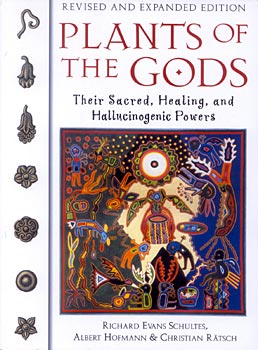
REVIEWS, EXCERPTS, & COMMENTS #
BACK COVER #
In the traditions of every culture, plants have been highly valued for their nourishing, healing, and transformative properties. The most powerful of those plants, which are known to transport the human mind into other dimensions of consciousness, have always been regarded as sacred.In this book, the world's most renowned authorities on psychoactive flora provide a fascinating and moving testimony of these "plants of the gods", tracing their use throughout the world and their significance in shaping history and culture.
Of the ninety-one hallucinogenic plant beautifully illustrated and characterized in their lexicon, the authors elaborate in vivid detail on fourteen that have had profound significance for human beings. Drawing on fourteen years of field work, Dr. Richard Evans Schultes describes pilgrimages made to gather the sacred plants as well as the rites, prayers, songs, and dances associated with their use. His accounts are augmented by Dr. Albert Hofmann's lucid explanations of the biochemistry of these psychotropic substances.
The text is accompanied by numerous illustrations, more than one hundred of which are in full color. Included are rare photographs -- many published here for the first time -- of plants and the people who have used them as well as ceremonies, sculpture, paintings, pottery, and weavings related to the ritual use of these sacred hallucinogens.
BLURBS #
. . . an extraordinary blend of botany, ethnootany, chemistry, history, mythology, and art. A visual, spiritual, and intellectual feast, Plants of the Gods is the best book ever written on hallucinogenic plants . . . -- Dr. Mark Plotkin, Conservation International
"Carefully researched, beautifully written, and abundantly illustrated, this book reminds us that the use of hallucinogenic plants has been a fundamental part of human experience for millennia."
-- Michael R. Aldrich, Ph.D., Curator of the Fitz Hugh Ludlow Library
". . . shows the importance of the rituals and ceremonies of tribal peoples for the discovery and conservation of new medicines . . . a volume that anyone interested in medicinal plants, economic botany, or ethnobotany would want to possess."
-- Ghillean T. Prance, Director Royal Botanic Gardens


